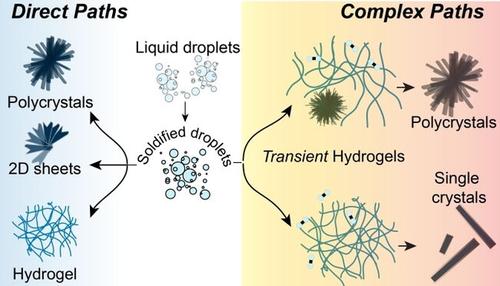当前位置:
X-MOL 学术
›
Angew. Chem. Int. Ed.
›
论文详情
Our official English website, www.x-mol.net, welcomes your
feedback! (Note: you will need to create a separate account there.)
Complex Pathways Drive Pluripotent Fmoc-Leucine Self-Assemblies
Angewandte Chemie International Edition ( IF 16.1 ) Pub Date : 2024-06-02 , DOI: 10.1002/anie.202406220 Subir Paul 1 , Kousik Gayen 1 , Pau Gil Cantavella 1 , Beatriu Escuder 1 , Nishant Singh 1
Angewandte Chemie International Edition ( IF 16.1 ) Pub Date : 2024-06-02 , DOI: 10.1002/anie.202406220 Subir Paul 1 , Kousik Gayen 1 , Pau Gil Cantavella 1 , Beatriu Escuder 1 , Nishant Singh 1
Affiliation

|
A range of hierarchical assemblies of Fmoc-Leu are accessed using non-classical and classical nucleation following complex pathways. Chemical and thermal inputs lead to phase separated sub-micron liquid and solid droplets which can transform to fibrous stable hydrogel, transient metastable hydrogels, and milli-metric polycrystal spherulites or single crystals.
中文翻译:

复杂的途径驱动多能 Fmoc-亮氨酸自组装
Fmoc-Leu 的一系列分层组装可通过遵循复杂途径的非经典和经典成核来获得。化学和热输入导致相分离的亚微米液体和固体液滴,这些液滴可以转变为纤维状稳定水凝胶、瞬态亚稳定水凝胶和毫米级多晶球晶或单晶。
更新日期:2024-06-02
中文翻译:

复杂的途径驱动多能 Fmoc-亮氨酸自组装
Fmoc-Leu 的一系列分层组装可通过遵循复杂途径的非经典和经典成核来获得。化学和热输入导致相分离的亚微米液体和固体液滴,这些液滴可以转变为纤维状稳定水凝胶、瞬态亚稳定水凝胶和毫米级多晶球晶或单晶。


















































 京公网安备 11010802027423号
京公网安备 11010802027423号